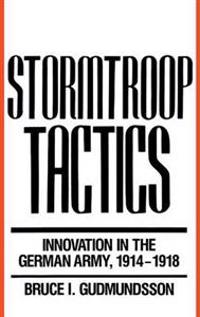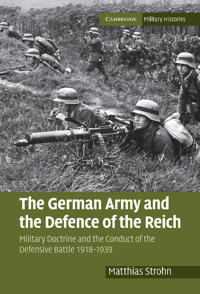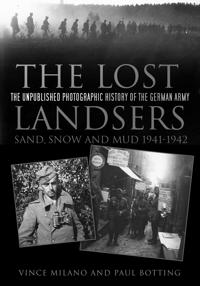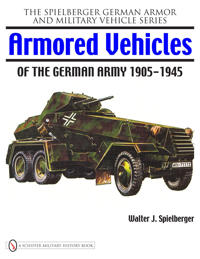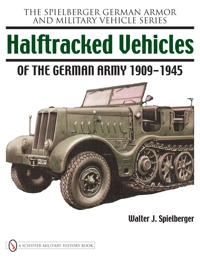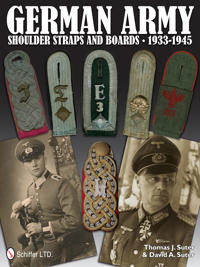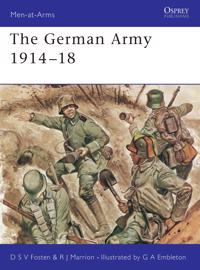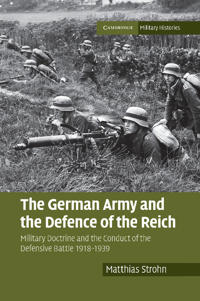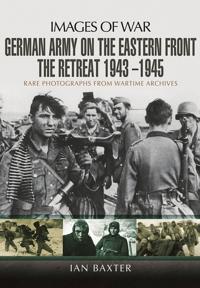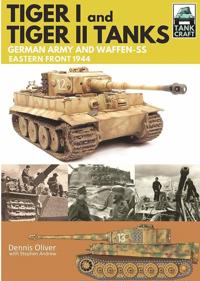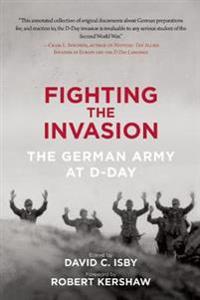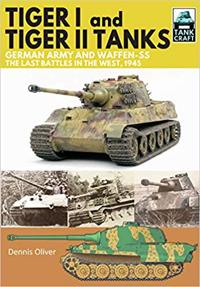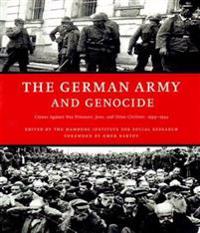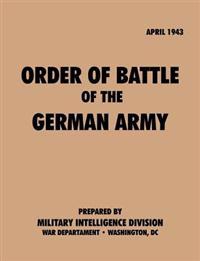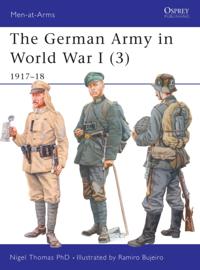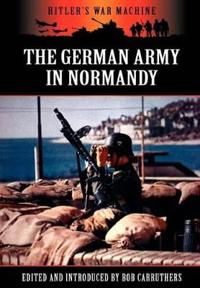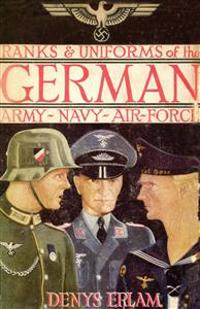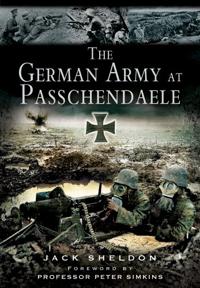The German Army League (Inbunden)
avMarilyn Shevin Coetzee
ISBN: 9780195061093 - UTGIVEN: 1990-06-28Stormtroop Tactics: Innovation in the German Army, 1914-1918 (Inbunden)
avBruce I. Gudmundsson
ISBN: 9780275933289 - UTGIVEN: 1989-11Describing the radical transformation in German Infantry tactics that took place during World War I, this book presents a detailed account of the evolution of stromtroop tactics. It covers areas such as the German Infantry's tactical heritage, the squad's evolution as a tactical unit, the use of new[...]
The German Army and the Defence of the Reich (Inbunden)
avMatthias Strohn
ISBN: 9780521191999 - UTGIVEN: 201011Historical research on the German army of the interwar period has concentrated on the development of the so-called 'Blitzkrieg'. However, Matthias Strohn shows that for most of the time the German army, restricted by the terms of the Versailles Treaty, was too weak to launch an offensive war or even[...]
Cossacks in the German Army 1941-1945 (Pocket)
avSamuel J. Newland
ISBN: 9780714681993 - UTGIVEN: 2002-09-29The Lost Landsers: The Unpublished Photographic History of the German Army: Sand, Snow and Mud, 1941-1942 (Häftad)
avVince Milano, Paul Botting
ISBN: 9780752498768 - UTGIVEN: 2014-05A collection of photographs of the German Army never before published or released in any form, accompanied by expert descriptions and the words of the last of the survivorsFrom 1939 to 1945 a generation of men sacrificed their youth for the wrong cause and then rejoined a society that wanted to forg[...]
Armored Vehicles of the German Army 1905-1945
ISBN: 9780764329418 - UTGIVEN: 2008-03This classic, definitive series continues with this volume on German armored vehicles from 1905-1945. Spielberger, a leading expert in the field of German military vehicles, presents the wide variety of four-, six-, and eight-wheeled types and their wide range of uses in this richly illustrated tech[...]
Halftracked Vehicles of the German Army 1909-1945
ISBN: 9780764329425 - UTGIVEN: 2008-03This classic, definitive series continues with this volume on German halftracked vehicles from 1909-1945. Spielberger, a leading expert in the field of German military vehicles, presents the wide variety of halftracked types and their wide range of uses in this richly illustrated technical documenta[...]
Winter Uniforms of the German Army and Luftwaffe in World War II (Inbunden)
avVincent Slegers
ISBN: 9780764337529 - UTGIVEN: 201105This is the first thorough and in-depth study to cover all aspects of the winter uniforms issued to and used by the ground-based troops of the German Army and Air Force during World War II. This book offers a definite overview, covering all uniform pieces and accessories, ranging from coats to scarv[...]
German Army Shoulder Boards and Straps 1933-1945 (Inbunden)
avThomas J. Suter
ISBN: 9780764340376 - UTGIVEN: 2012-06One of the distinguishing features of the World War II German Army uniform is the use of shoulder straps and boards to denote rank, branch of service, and in some cases the assigned unit right down to the company. This heavily illustrated book covers construction methods, material, types and styles [...]
The German Army 1914-18 (Pocket)
avD. Fosten
ISBN: 9780850452839 - UTGIVEN: 1978-06The Imperial German Army began the Great War (World War I) as the most professionally impressive conscript force in the world. This fascinating book by Donald Fosten and Robert Marrion explores in great detail the organization, tactics, weapons, uniforms, equipment and origins of this army that foug[...]
The German Army and the Defence of the Reich
ISBN: 9781316633694 - UTGIVEN: 2017-02Historical research on the German army of the interwar period has concentrated on the development of the so-called 'Blitzkrieg'. However, Matthias Strohn shows that for most of the time the German army, restricted by the terms of the Versailles Treaty, was too weak to launch an offensive war or even[...]
German Army on the Eastern Front - The Retreat 1943 - 1945 (häftad)
ISBN: 9781473822672 - UTGIVEN: 2016-02After the defeat at Stalingrad in January 1943, the German Army's front lines were slowly smashed to pieces by the growing might of the Soviet Army. Yet these soldiers continued to fight gallantly. Even after the failed battle of the Kursk in the summer of 1943, and then a year later when the Russ[...]
The German Army on the Eastern Front
ISBN: 9781473861749 - UTGIVEN: 2018-08Histories of the German army on the Eastern Front generally focus on battlefield exploits on the war as it was fought in the front line. They tend to neglect other aspects of the armys experience, particularly its participation in the racial war demanded by the leadership of the Reich. This ground-b[...]
Tiger i and tiger ii: tanks of the german army and waffen-ss - eastern fron (häftad)
ISBN: 9781473885349 - UTGIVEN: 2016-10In spite of the relatively small numbers produced, the Tiger I and Tiger II tanks are arguably the most famous armoured fighting vehicles of the Second World War. This book, the first in the TankCraft series, uses archive photos and extensively researched colour illustrations to examine the tanks an[...]
Tiger I and Tiger II: Tanks of the German Army and Waffen-SS
ISBN: 9781473885363 - UTGIVEN: 2016-10In spite of the relatively small numbers produced, the Tiger I and Tiger II tanks are arguably the most famous armoured fighting vehicles of the Second World War. This book, the first in the TankCraft series, uses archive photos and extensively researched colour illustrations to examine the tanks an[...]
Fighting the Invasion: The German Army at D-Day (häftad)
ISBN: 9781510703575 - UTGIVEN: 2016-03In one of history s most violent battles, Allied troops gathered along the shores of southern England, preparing for the invasion of Hitler's Fortress Europe. Facing themfrom the Pas de Calais to Brittanywere German troops, dug in, waiting and preparing for the inevitable confrontation.
History [...]Tiger I and Tiger II Tanks, German Army and Waffen-SS, The Last Battles in the West, 1945 (häftad)
ISBN: 9781526741820 - UTGIVEN: 2019-02Tiger tanks were among the most-feared fighting vehicles of the Second World War and they gained almost legendary status, yet they never fulfilled their potential because they were not produced in sufficient numbers and the tide the war had turned against the German army by the time they were introd[...]
The German Army and Genocide (Häftad)
avHamburg Institute For Social Research
ISBN: 9781565845251 - UTGIVEN: 1999-12For the better part of fifty years, the powerful German army of World War II has been seen as an organization of consummate skill and honor, one that had little in common with the criminal policies and ideology of the Nazi regime. The German Army and Genocide explodes that myth.. "Through newly disc[...]
Order of Battle of the German Army, April 1943 (Häftad)
avMilitary Intelligence Service, War Department
ISBN: 9781780390819 - UTGIVEN: 201108German Army in World War I (3)
ISBN: 9781780965765 - UTGIVEN: 2015-06This third volume of a mini-series covering the German forces in World War I examines the troops that fought during the climax of the war on all fronts: the last great battles of attrition in the West (Arras, Messines, 3rd Ypres Passchendaele/Langemarck and Cambrai, 1917) and the collapse of Russia [...]
The German Army in Normandy
ISBN: 9781781592267 - UTGIVEN: 2013-09This fascinating collection of primary source accounts focuses on the combat actions of the Wehrmacht in Normandy. The material is drawn from a variety of wartime sources and encompasses fascinating writings concerning the tactical, operational and strategic aspects of the battle for Normandy. Comp[...]
RANKS & UNIFORMS OF THE GERMAN ARMY, NAVY & AIR FORCE (1940) (häftad)
ISBN: 9781783311378 - UTGIVEN: 2014-08The German Army at Passchendaele (Pocket)
avJack Sheldon
ISBN: 9781783461820 - UTGIVEN: 2014-04Even after the passage of almost a century, the name Passchendaele has lost none of its power to shock and dismay. Reeling from the huge losses in earlier battles, the German army was in no shape to absorb the impact of the Battle of Messines and the subsequent bitter attritional struggle. Througho[...]



